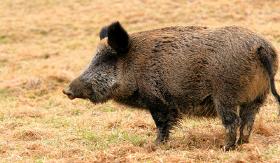It's a New Day in Public Health.
The Florida Department of Health works to protect, promote, and improve the health of all people in Florida through integrated state, county, and community efforts.
Brucellosis
Florida Health
Disease Control- DiseaseControl@flhealth.gov
- 850-245-4444
-
Florida Health
4052 Bald Cypress Way
Tallahassee, FL 32399

Brucellosis is a relatively rare, but epidemiologically important zoonotic disease caused by Brucella bacterium. The most common species of Brucella isolated from Florida patients is B. suis, which is endemic in Florida feral hogs. Brucella melitensis and B. abortus are not found in Florida. However, these species may cause infections in Florida residents with travel to developing countries where these species are still endemic in domestic goats, sheep and cattle.
- SYMPTOMS
- TRANSMISSION
- OCCURRENCE OF BRUCELLOSIS IN FLORIDA
- INFORMATION FOR HUNTERS
- INFORMATION FOR PHYSICIANS, HEALTH CARE PROVIDERS AND LABORATORIANS
- RESOURCES AND REFERENCES
The symptoms of brucellosis are non specific and may wax and wane. The most consistent symptom of brucellosis is intermittent or constant fever. Other common symptoms include headaches, chills, arthralgia (joint pain), and weight loss. Chronic infection can lead to localized disease such as osteomyelitis or endocarditis. Heymann's Control of Communicable Disease Manual states: "The disease is often unrecognized and underreported." If a patient has unexplained recurring fever, it is important to assess whether or not they hunt or handle meat from feral hogs or have other possible exposures to Brucella such as international travel with consumption of unpasteurized milk products. Relapse in infection is common if patients have incomplete or inappropriate treatment (monotherapy), or have underlying medical conditions.
Persons can become infected with Brucella when open cuts or mucous membranes come in contact with pig blood, raw meat or organs during the butchering process. Though rare, hunters' family members have also acquired Brucella, presumably from preparing wild hog meat, through other contact with hog's blood, or through ingestion of undercooked meat.
Due to the naturally occurring infection in feral hogs, hog hunters are at increased risk of developing brucellosis. Of the 10 reported cases of brucellosis in 2008, seven were associated with wild pig hunting or preparation of wild pig meat. Feral hog data collected by USDA indicate seroprevalences as high as 50% in some feral swine herds in central Florida, and statewide prevalence is estimated to be 10-20%. In 2008 (and 2009), a majority of cases of Brucella acquired in Florida were in residents of central Florida, but were also identified in other parts of the state.
Brucella melitensis, B. suis and B. abortus are considered bioterrorism agents, in part because of the low infectious dose required to cause illness (only 10-100 bacteria). Amplification of bacteria in culture increases bacteria numbers and also the likelihood of aerosolization, putting laboratory workers at risk. Each year in Florida, multiple laboratory workers are exposed to Brucella, most often because they were not advised that a sample might contain Brucella. In 2009, more than 90 Florida laboratory workers were exposed to Brucella and one Florida specimen likely caused brucellosis in a laboratory worker in another state.
Practice good sanitation when handling feral swine or raw feral swine meat, they can carry a number of disease organisms including bacteria and parasites such as Brucella and Trichinella. To protect against these and other agents:
- Avoid eating, drinking or using tobacco when field-dressing or handling carcasses.
- Use latex or rubber gloves when handling the carcass or raw meat.
- Avoid direct contact with blood, reproductive organs and fecal matter.
- Wearing long sleeves, eye protection and covering any scratches, open wounds or lesions will help provide protection.
- Clean and disinfect knives, cleaning area, clothing and any other exposed surfaces when finished.
- Wash hands frequently with soap and water.
- Cook meat from these animals to 160 ºF or until juices run clear
Contact your county health department for more information about Brucella and other diseases hunters can be exposed to through pigs.
If Brucella is suspected, please notify the laboratory in advance so that they can take additional precautions to prevent unnecessary staff exposures. In addition, please notify the health department immediately upon suspicion or laboratory test order for Brucella, 24/7 by phone per Florida Rule 64-D3.
Brucellosis Information for Public Health Officials and Health Care Providers
CDC Guidelines for Safe Work Practices in Human and Animal Medical Diagnostic Laboratories (2012)
CDC Biosafety in Microbiological and Biomedical Laboratories (BMBL) 5th Edition
Laboratory acquired Brucella--Indiana and Minnesota, 2006 MMWR
Laboratory exposure risk assessment
CDC-Presumptive Brucella spp. Identification and Similar Organisms Table
For more information on Brucella please visit https://www.cdc.gov/brucellosis/
Resources
Perspectives for the Treatment of Brucellosis in the 21st Century: The Ioannina Recommendations MMWR
Public Health Consequences of a False Positive Laboratory Test Result for Brucella-EIA MMWR
Brucellosis in Feral Swine Hunters MMWR
CDC Resources for Brucellosis Prevention
References
Heymann, David. (2008). Control of communicable diseases manual. Amer Public Health Assn.
Florida Morbidity Statistics Report, 2008. (2009). Florida Department of Health.



Connect with DOH